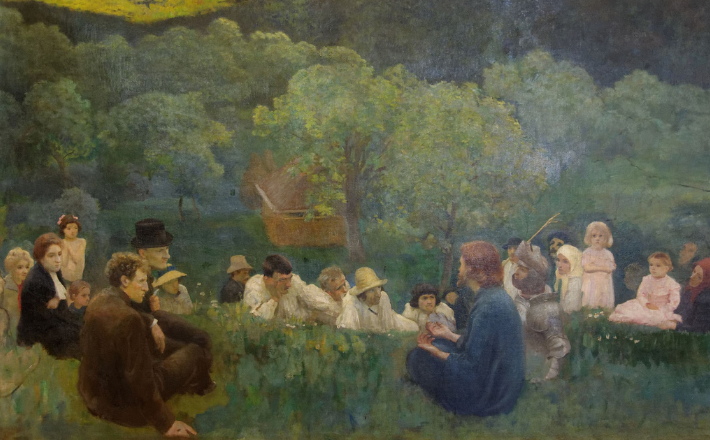Commentary on Revelation 7:9-17
Sandwiched between the opening of the sixth and seventh seals, John sees a great multitude of people waving palms, offering praise to God, and wearing robes made white in the blood of the Lamb. Those gathered are too numerous to count, made up of people from every nation, tribe, and language.
The crowd John sees cries out that salvation belongs to God. In the opening letters to the book of Revelation (Revelation 2-3), one of John’s biggest complaints about the seven churches is that they are not directing their worship to the right person. Rome, too, promised salvation. But John sets things straight. Salvation does not come from Rome. Salvation comes from God.
Like the elder who addresses John, you might wonder, “Who are these, robed in white, and where have they come from?”
Many have set the innumerable crowd John sees in verse 9 in contrast with the numbered crowd he hears in verse 4. I offer here a word of caution. Readings that contrast the two risk engendering supersessionism. Replacement theology does not fit well within John’s message to the seven churches. It is good for us to appeal to the inclusivity and diversity represented in verse 9, but there is no need to set these descriptors in contrast with Israel.
In reply, John turns the question back on the elder before the elder answers his own question: “These are they who have come out of the great ordeal; they have washed their robes and made them white in the blood of the Lamb (verse 14).” But what does it mean to be washed in the blood of the lamb? While popular hymns often suggest a substitutionary transaction—Jesus’ blood washes away our sins and thereby cleanses our soul—a closer look at Revelation 7:9-17 offers a different reading.
Lamb, used more than two dozen times, is John’s predominant title for Jesus in the book of Revelation. While the Lamb is presented in a variety of ways, two repeated images have led interpreters to read the Lamb as a sacrifice: four times John depicts Jesus as a slaughtered lamb (5:6, 9, 12; 13:8) and three times as a bloodied lamb (5:9, 7:14, 12:11). Interpreters often hear in these repeated images of a slaughtered and bloodied lamb a reference to the Passover story and to the blood of the paschal lamb spread on the doorposts of the Hebrews in Egypt (Exodus 12:1-13). Given the lack of sacrificial language in Revelation, this reading is not convincing. John has something else up his sleeve.
John’s use of the verb slaughter (sphazō) better illustrates its meaning in Revelation. Aside from the references to the Lamb, the verb appears four more times (6:4, 6:9, 13:3, 18:24). In each occurrence, it points to the violence of Rome.
For example, slaughter, outside of its description of the lamb, occurs in the opening of the second and fifth seals. The first and second seal recall the violence of Rome’s military conquests (6:1-4). The third and fourth seals emphasize the economic injustices of Roman rule and the death that accompanies food shortages and famine as a result of war (6:5-8). The fifth seal images victims of imperial violence under an altar pleading for God to intervene and end their suffering. The final two seals announce Rome’s impending judgment (6:12-17, 8:1-5). Rome will be held accountable. Taken together, the opening of the seven seals evokes Rome’s modus operandi. Rome slaughters. The slaughtered lamb is a reminder.
Blood, a term used nineteen times in Revelation, also points to the violence of Rome. John repeatedly lays the blood of the faithful saints, prophets, witnesses, and servants at the feet of empire (6:10, 16:6, 17:6, 18:24, 19:2). The victims under the altar cry out to God, “How long will it be before you judge and avenge our blood?” (6:10). Rome’s hands are covered in the blood of God’s faithful. By repeatedly coming back to the image of blood shed at the hands of the Romans, John rhetorically paints Rome as bloodthirsty and sadistic. The bloodied lamb is yet another reminder.
In short, John does not want his audience to forget how Jesus died. Jesus died a violent death at the hands of Rome. Post-resurrection, the Lamb’s wounds are still visible. They remind us that we must not forget or look away from the wounds of those who have suffered imperial violence.
The white robes recall John’s description of those under the altar in the opening of the fifth seal. In response to their testimony, John notes “they were each given a white robe and told to rest a little longer” (5:11). This image suggests that the heavenly altar is a place where the souls of God’s faithful can bring their cries for justice. The altar is a place where victims of violence can air their grievances against Rome and other systems of oppression. It is a place where the voices of the suffering are heard.
The image of the souls bearing witness to the violence of Rome at the foot of the heavenly altar begs the question, “what does it mean to be a witness to violence today?” It forces readers to ask who is bearing witness to and bearing the scars of empire in our own context. I hear in this question the testimonies to violence on the streets of US cities as protestors cry out “No Justice! No Peace!” I see the posters of teenagers picketing state legislatures for trans rights. I hear the cries of parents calling for stricter gun control on the heels of another school shooting.
To be washed in the blood of Jesus means to join the Lamb and God’s faithful in testimony to the violence of the world. This All Saints Sunday may we be willing to identify the victims of violence and testify to the systems of oppression in our own imperial context.



November 5, 2023